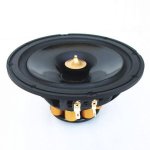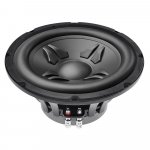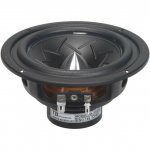A cone doesn't always bend significantly during operation. Usually at lower frequencies it operates 'pistonically'. At higher frequencies it can bend in varying patterns, called breakup, with varying effects.
You note correctly that the cone moves along one axis. The directivity is not necessarily related to the shape of the cone. However the resulting wavefront can, in a certain range of frequencies be affected by the shape of the cone.
These are words to explain the actions. Piston is something that goes to-and-fro. Frequency is something which explains speed it bends one way and then bends the other way. Well, the word wavefront is coined word, a wave doesn't really have a front, when a wave hits some object, it is at some level of the wave. It might be even at zero, but the next wave hits the same object (the ear tract and through it), some point of the wave above or below zero, so we hear different sounds. Bit off topic. 🙂
The manufacturers don't talk much or at all about the vibrations happening on the cone surface, which are larger at the bottom, smaller at the top. Anyway, while the current is going through the coil, it gives sound, even without any surface attached to it, for it vibrates, and in every plane. In a audio driver, its side movements are somewhat restricted at the top with suspension and the cone's bottom, but they happen. Some hear a coil "whine" sometimes. Every surface around the coil vibrates in audio driver, even the basket. And, give sound.
... If you manage to do this, then the cone radiates sound that is proportional to the voltage signal from the source.
OK, the question still is how the cone "radiates" the sound waves. Does it move like a solid piston, as a solid, or as a thin angled surface, which can also bend, or vibrate on its own plane(s)?
The cone is only finitely stiff. If you look at a cross-section of the cone under motion, it will be moving front-and-back with some simple Hooke-like bending from coil former joint to surround joint.OK, the question still is how the cone "radiates" the sound waves. Does it move like a solid piston, as a solid, or as a thin angled surface, which can also bend, or vibrate on its own plane(s)?
Some scientific papers found in the net. One from University of Southampton, UK and the other from University of Technology, Dresden, Germany.
Attachments
Last edited:
I should've mentioned earlier in my comment that simple bending is in the frequency band of pistonic motion (i.e. before breakup). There is nothing "new" in the article you linked, though it is a pretty clear high-level explanation of what is going on in a cone.Below the ring frequency the dynamics are dominated by the membrane stiffness, resulting in mostly in-plane motion. Above the ring frequency the dynamics are dominated by the bending stiffness, resulting in flexural motion.
In Fig.3, the cone moves almost as a rigid body at low frequency, 100Hz for example, since the frequency is in region I. At higher frequencies, 2 kHz and 3 kHz when the excitation frequency is in region II, cone “break-up” occurs, in which the cone no longer vibrates as a rigid body, but some sections of the cone still move in phase.
Guys, chdsl is trolling you.
This fake thread will last only as you want to sink valuable time into it.
The "seemingly" innocent "noob who has NO clue" questions in posts 1 and 4 quickly turns into derising fellow user tmuikku in posts 6 and 8 and 13, where it gets frankly insulting.
Post 24 linking to papers on advanced Acoustics is absolutely inconsistent with the "innocent noob" image shown at thread beginning.
DON´T FEED THE TROLL
This fake thread will last only as you want to sink valuable time into it.
The "seemingly" innocent "noob who has NO clue" questions in posts 1 and 4 quickly turns into derising fellow user tmuikku in posts 6 and 8 and 13, where it gets frankly insulting.
Post 24 linking to papers on advanced Acoustics is absolutely inconsistent with the "innocent noob" image shown at thread beginning.
DON´T FEED THE TROLL
Jeah kind of felt like a troll from the start, but had to write some 😀 Sometimes ignorance and trolling feel the same.
I should've mentioned earlier in my comment that simple bending is in the frequency band of pistonic motion (i.e. before breakup). There is nothing "new" in the article you linked, though it is a pretty clear high-level explanation of what is going on in a cone.
I said something I found in the net. I am still looking at other papers, but most probably won't link them here. Maybe, I shouldn't have linked any articles/papers at all. Not everyone has Physics background/knowledge. 🙂
Anyway, I have been doing the following; pasting rings on the driver cone at different distances from the center (one at a time, few together etc), pasting a plastic ball at the center, pasting a paper cone, one larger than the dust cover, one smaller than dust cover resting on it, and some more. It is up to you to test/experiment, if you so desire. It is DIY, after all. Not only DIY enclosure, but DIY on the driver itself. Find out how you can hamper or add to the cone vibrations and the type of sound you'd hear. You try, you find out, there's no other way.
Last edited:
With my 8" B.I.C Venturi (3 way) bookshelf speakers the piston effect was quite obvious with heavy bass but with my current K5s cone excursion is not obvious yet bass performance is comparable or maybe better.
If you have one of the old "Whole Earth Catalog"s, they have a speaker project where they glue wooden sticks onto the woofer cone radially to stiffen it. Back in 1968. I always wondered about that idea.
I once took a strobe light and observed the motion of a drum head when struck. You could clearly see different parts of the flat head moving in relative motions. Today with bright LED illumination setup as a strobe, I'd expect you could see relative motion on a conical surface at various frequencies. The so-called "breakup". Never liked that name...
So you could approach this from an empirical observation on a particular speaker. Maybe even glue wood sticks across a particularly offending section. Or maybe even get to see what the "enable" process actually does. Or maybe see nothing -
I once took a strobe light and observed the motion of a drum head when struck. You could clearly see different parts of the flat head moving in relative motions. Today with bright LED illumination setup as a strobe, I'd expect you could see relative motion on a conical surface at various frequencies. The so-called "breakup". Never liked that name...
So you could approach this from an empirical observation on a particular speaker. Maybe even glue wood sticks across a particularly offending section. Or maybe even get to see what the "enable" process actually does. Or maybe see nothing -
Last edited:
You can take your pick from different manufacturers. There are hundreds of them out there.
Or, create your own.
Or, create your own.
Attachments
Last edited:
Dual cone angle, grooves in the middle (pseudo surround ?), varying cone thickness, at the top much thicker...separate parts of the cone radially vibrates differently creating different sound waves, even the dome in the middle (dust cap). One example below. Few more are out there...
Attachments
Last edited:
I fear we are in danger of falling off the edge, TNT! Who knows what lies beyond? 😉Why are we discussing this. Flatearthers?
Watch an easy to buy full range speaker making music. How the cone distorts on its surface. How the shiny cone in the middle tweets, without moving.
Last edited:
Guys, chdsl is trolling you.
This fake thread will last only as you want to sink valuable time into it.
The "seemingly" innocent "noob who has NO clue" questions in posts 1 and 4 quickly turns into derising fellow user tmuikku in posts 6 and 8 and 13, where it gets frankly insulting.
Post 24 linking to papers on advanced Acoustics is absolutely inconsistent with the "innocent noob" image shown at thread beginning.
DON´T FEED THE TROLL
+1. Don't waste your time guys & girls. An 'innocent' question is asked by the OP in his first post, who a few posts later starts lecturing. The basic principles behind the operation of electrodynamic wideband drivers and their use of both piston (oscillatory) and resonant action are not a mystery, nor 'belief', just practical engineering, and anybody who wishes to learn can freely ask members who are familiar with the subject, of which there are a number here. Some of whom even design such drive units, or work with those who do.
Yup, if he were an experimenter he would probably post some metrics of his results. He claims to be a DIYer but has offered nothing to benefit others. His other thread is similar. Maybe the mods will close his threads.
Let's think this thru...first off we 'should' assume the structure of a cone is like any material, in that, it has a stretching value, a zone where it can be deformed & will return to its original 'length', past which will deform permanently.
So we are ramping up a force trying to move it, & assuming it has little mass, we easily move it on the voice-coil end...the structure deforms as a wave traversing the length until it reaches the surround. But what is happening when the applying force stops & reverses direction before the first application of force can move the entire length of the cone?
Let us not yet consider reflections of the wave when it reaches the end. Further, what speed is this applied force imparted into the cone, is it faster than the speed of sound as many materials do indeed traverse?
Can-o-worms here...
-------------------------------------------------------------------Rick.....
So we are ramping up a force trying to move it, & assuming it has little mass, we easily move it on the voice-coil end...the structure deforms as a wave traversing the length until it reaches the surround. But what is happening when the applying force stops & reverses direction before the first application of force can move the entire length of the cone?
Let us not yet consider reflections of the wave when it reaches the end. Further, what speed is this applied force imparted into the cone, is it faster than the speed of sound as many materials do indeed traverse?
Can-o-worms here...
-------------------------------------------------------------------Rick.....
- Status
- Not open for further replies.
- Home
- Loudspeakers
- Full Range
- What do you think makes sound in a driver?





